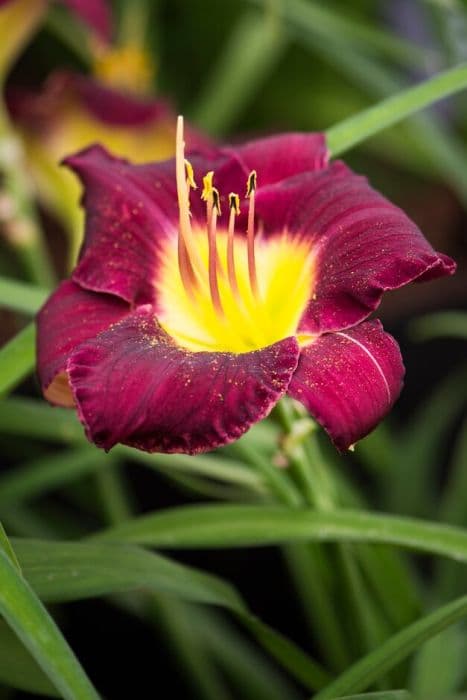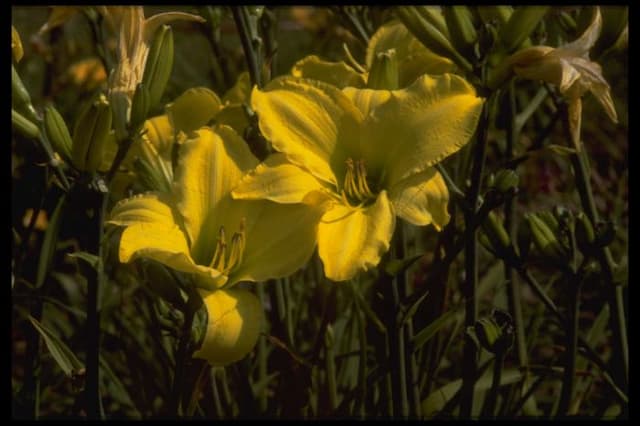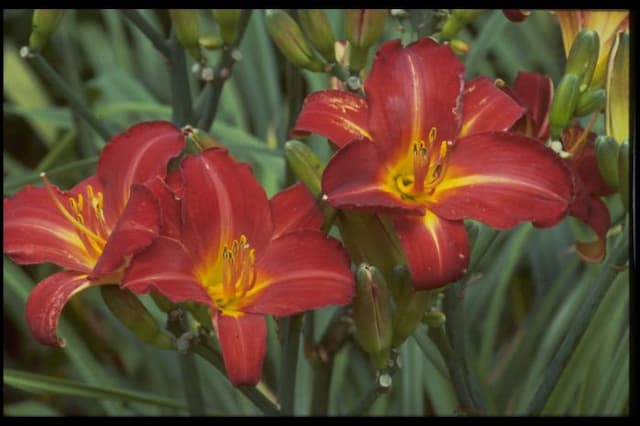New Zealand Flax Phormium 'Black Adder' (PBR)

ABOUT
Phormium 'Black Adder', also commonly known as New Zealand flax, is an evergreen perennial known for its striking and bold appearance. It is characterized by its long, sword-like leaves which display a deep burgundy or almost black coloring that adds a dramatic flair to any garden setting. The foliage itself is arching, forming a clump that is both graceful and architectural in design. The upright nature of its leaves allows for a textured landscape presence, offering a visual interest that persists throughout the seasons. In terms of the flowers, New Zealand flax produces tall flower spikes that rise above the foliage, bearing tube-like flowers that may attract birds and other wildlife. The blooms can vary in color but are often a contrast to the dark leaves, adding another layer of decorative appeal. The overall aesthetic of Phormium 'Black Adder' is one of elegance and exotic charm, providing a striking feature in gardens where a touch of dark foliage is desired. It is also commonly used in contemporary garden designs, where its distinct form and color can be juxtaposed against lighter and brighter plants for a dynamic effect.
About this plant
 Names
NamesFamily
Asphodelaceae
Synonyms
New Zealand Flax, Black New Zealand Flax, Black Adder Flax
Common names
Phormium 'Black Adder' (PBR)
 Toxicity
ToxicityTo humans
New Zealand Flax 'Black Adder' is not commonly listed as a toxic plant to humans. However, as with many plants, it may cause irritation or an allergic reaction in sensitive individuals if they come in contact with the sap or leaves. There is no widespread documentation of poisoning from ingestion of this plant, but it is generally advisable to avoid eating ornamental plants.
To pets
New Zealand Flax 'Black Adder' is also not commonly listed as a toxic plant to pets such as dogs and cats. However, as with humans, individual animals may have allergic reactions or gastrointestinal irritation if they ingest parts of the plant. Monitor pets to prevent them from chewing on the leaves, and consult a veterinarian if you suspect your pet is having an adverse reaction after ingesting this plant.
 Characteristics
CharacteristicsLife cycle
Perennials
Foliage type
Evergreen
Color of leaves
Dark purplish-bronze
Height
4-5 feet (1.2-1.5 meters)
Spread
3-4 feet (0.9-1.2 meters)
Plant type
Shrub
Hardiness zones
8-11
Native area
New Zealand
Benefits
 General Benefits
General Benefits- Low maintenance: Phormium 'Black Adder' is known for being easy to care for, requiring minimal attention once established.
- Drought tolerance: Adapted to survive in dry conditions, making it suitable for water-wise gardens.
- Architectural form: Offers strong vertical lines and a dramatic presence, useful in garden design.
- Evergreen foliage: Provides year-round interest with its sword-shaped, dark purplish-black leaves.
- Frost hardy: Can withstand cold temperatures, making it suitable for a range of climates.
- Pest resistance: Generally resistant to pests, reducing the need for chemical treatments.
- Wind resistance: Tough and able to endure exposed, windy conditions.
- Versatility: Can be used in mixed borders, as a specimen plant, or in containers.
- Ornamental flowers: Produces dramatic flower spikes that can add an exotic touch to the garden.
- Habitat support: Attracts birds and provides material for nesting in some regions.
 Medical Properties
Medical PropertiesThis plant is not used for medical purposes.
 Air-purifying Qualities
Air-purifying QualitiesThis plant is not specifically known for air purifying qualities.
 Other Uses
Other Uses- Textile Dyeing - The long, sword-like leaves of New Zealand Flax can be boiled to extract natural dyes for coloring fabrics.
- Traditional Weaving - Maori cultures use the strong fibers of New Zealand Flax leaves for weaving baskets, mats, and other handicrafts.
- Erosion Control - Because of its dense rooting system, New Zealand Flax can be planted to stabilize banks and prevent soil erosion.
- Livestock Fodder - Though not a common use, the leaves of New Zealand Flax can be fed to livestock in times of fodder scarcity.
- Garden Sculpture - The rigid, upright habit of the New Zealand Flax makes it a natural choice for creating living garden sculptures or accents.
- Water Filtration - The dense roots and ability to grow in damp conditions allow New Zealand Flax to be used in constructed wetlands for water filtration and purification.
- Photography Backdrop - The dark foliage of 'Black Adder' serves as a dramatic backdrop for garden photography and plant compositions.
- Cultural Symbolism - In New Zealand, the flax is a traditional symbol for family and whanaungatanga, or kinship, often used symbolically in artwork and celebrations.
- Privacy Screening - Taller varieties of New Zealand Flax can be planted in rows to create a natural, living privacy screen for gardens and outdoor living areas.
- Floral Arrangements - The striking leaves and seed heads of New Zealand Flax can be used in both fresh and dried floral arrangements for their unique texture and form.
Interesting Facts
 Feng Shui
Feng ShuiThe New Zealand Flax is not used in Feng Shui practice.
 Zodiac Sign Compitability
Zodiac Sign CompitabilityThe New Zealand Flax is not used in astrology practice.
 Plant Symbolism
Plant Symbolism- Strength and Resilience: The rigidity and toughness of the Phormium 'Black Adder', also known as New Zealand Flax, often embody strength and the ability to withstand harsh conditions.
- Adaptability: As a plant that can grow in a variety of environments, New Zealand Flax can symbolize versatility and adaptability to life's circumstances.
- Mystery: The dark foliage of the 'Black Adder' variant signifies mystery and the unknown, perhaps due to its striking, unusual coloration.
- Elegance: With its striking appearance and unique form, New Zealand Flax can represent elegance and sophistication in the plant world.
 Water
WaterNew Zealand Flax 'Black Adder' should be watered regularly but it's crucial to let the soil dry out between waterings to prevent root rot. In general, during the growing season, water about once a week, providing about one to two gallons per plant. Adjust the frequency based on temperature, humidity, and rainfall, decreasing water in cooler months. It's best to water deeply and less frequently to encourage deep root growth. During winter or in cooler climates, water less often, possibly every two weeks with a reduced amount of around one gallon, always depending on the plant's needs and weather conditions.
 Light
LightNew Zealand Flax 'Black Adder' thrives best in full sun to partial shade. It should be placed in a spot where it can receive at least six hours of sunlight per day. While it can manage in lighter shade, the intensity of its leaf color and overall health can be maximized with adequate sun exposure.
 Temperature
TemperatureNew Zealand Flax 'Black Adder' prefers mild to warm temperatures, ideally between 60 and 75 degrees Fahrenheit. It can survive temperatures down to about 20 degrees Fahrenheit but is at risk of damage if temperatures drop lower. It handles heat well but should be protected from extremely hot temperatures above 90 degrees Fahrenheit.
 Pruning
PruningNew Zealand Flax 'Black Adder' should be pruned to remove dead or damaged leaves and to maintain its shape. Prune in late winter or early spring before new growth starts. Cutting back older foliage once a year encourages fresh, healthy growth. No precise schedule is required; simply monitor the plant for any browning or old leaves and remove them as needed.
 Cleaning
CleaningAs needed
 Soil
SoilNew Zealand Flax prefers well-draining soil mixed with compost and coarse sand, with a pH range of 5.5 to 7.5, ensuring good root aeration and moisture retention.
 Repotting
RepottingNew Zealand Flax should be repotted every 2-3 years, or when it outgrows its current pot, to maintain its health and vigor.
 Humidity & Misting
Humidity & MistingNew Zealand Flax thrives in average humidity levels typical of outdoor environments and does not require special humidity considerations when grown indoors.
 Suitable locations
Suitable locationsIndoor
Place New Zealand Flax in bright, indirect light with some direct sun.
Outdoor
Plant New Zealand Flax in full sun to partial shade in well-drained soil.
Hardiness zone
8-11 USDA
 Life cycle
Life cycleThe New Zealand Flax 'Black Adder' (Phormium 'Black Adder') begins its life cycle with seed germination, where seeds develop into small seedlings under appropriate conditions of warmth and moisture. The seedlings establish a root system and develop into juvenile plants, characterized by the emergence of the plant's distinctive sword-shaped, dark reddish-black leaves. As the plant matures, it enters the vegetative stage, during which it experiences significant growth in both foliage and root system size. When environmental conditions are favorable, 'Black Adder' reaches its flowering phase, producing tall flower spikes with tubular flowers that attract birds and insects for pollination. After pollination, seeds are developed, and once mature, they are dispersed from the parent plant to begin a new cycle. Throughout its life, Phormium 'Black Adder' may also propagate vegetatively through division of its rhizomatous root system to create genetically identical clones.
 Propogation
PropogationPropogation time
Spring-Early Summer
Phormium 'Black Adder', commonly known as New Zealand Flax, is typically propagated through division, which is the most popular method for this plant. The best time to propagate New Zealand Flax by division is in the spring when the plant is beginning to grow actively. To propagate by division, carefully dig up the plant and use a sharp, clean knife or spade to cut the rhizome into sections, making sure each section has at least one growing point or fan of leaves. The divisions can then be replanted in well-draining soil, ensuring that they are watered thoroughly and kept evenly moist until they establish in their new location. This method allows for relatively quick establishment and replication of desired plant characteristics.









